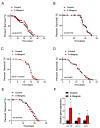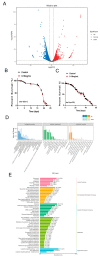APPA Increases Lifespan and Stress Resistance via Lipid Metabolism and Insulin/IGF-1 Signal Pathway in Caenorhabditis elegans
- PMID: 37761985
- PMCID: PMC10531162
- DOI: 10.3390/ijms241813682
APPA Increases Lifespan and Stress Resistance via Lipid Metabolism and Insulin/IGF-1 Signal Pathway in Caenorhabditis elegans
Abstract
Animal studies have proven that 1-acetyl-5-phenyl-1H-pyrrol-3-yl acetate (APPA) is a powerful antioxidant as a novel aldose reductase inhibitor independently synthesized by our laboratory; however, there is no current information on APPA's anti-aging mechanism. Therefore, this study examined the impact and mechanism of APPA's anti-aging and anti-oxidation capacity using the Caenorhabditis elegans model. The results demonstrated that APPA increases C. elegans' longevity without affecting the typical metabolism of Escherichia coli OP50 (OP50). APPA also had a non-toxic effect on C. elegans, increased locomotor ability, decreased the levels of reactive oxygen species, lipofuscin, and fat, and increased anti-stress capacity. QRT-PCR analysis further revealed that APPA upregulated the expression of antioxidant genes, including sod-3, gst-4, and hsp-16.2, and the critical downstream transcription factors, daf-16, skn-1, and hsf-1 of the insulin/insulin-like growth factor (IGF) receptor, daf-2. In addition, fat-6 and nhr-80 were upregulated. However, the APPA's life-prolonging effects were absent on the daf-2, daf-16, skn-1, and hsf-1 mutants implying that the APPA's life-prolonging mechanism depends on the insulin/IGF-1 signaling system. The transcriptome sequencing also revealed that the mitochondrial route was also strongly associated with the APPA life extension, consistent with mev-1 and isp-1 mutant life assays. These findings aid in the investigation of APPA's longevity extension mechanism.
Keywords: APPA; Caenorhabditis elegans; insulin/IGF-1; lifespan; stress resistant.
Conflict of interest statement
The authors declare no conflict of interest.
Figures









Similar articles
-
Hickory nut polyphenols enhance oxidative stress resilience and improve the longevity of Caenorhabditis elegans through modulating DAF-16/DAF-2 insulin/IGF-1 signaling.Phytomedicine. 2025 Jul 25;143:156918. doi: 10.1016/j.phymed.2025.156918. Epub 2025 May 27. Phytomedicine. 2025. PMID: 40466506
-
Ferulic Acid Supplementation Increases Lifespan and Stress Resistance via Insulin/IGF-1 Signaling Pathway in C. elegans.Int J Mol Sci. 2021 Apr 20;22(8):4279. doi: 10.3390/ijms22084279. Int J Mol Sci. 2021. PMID: 33924155 Free PMC article.
-
Cremastra appendiculata polysaccharides improve stress resistance and prolong the lifespan of Caenorhabditis elegans via daf-16 in the insulin signaling pathway.Int J Biol Macromol. 2023 Feb 28;229:496-506. doi: 10.1016/j.ijbiomac.2022.12.234. Epub 2022 Dec 26. Int J Biol Macromol. 2023. PMID: 36581039
-
DAF-16/FoxO in Caenorhabditis elegans and Its Role in Metabolic Remodeling.Cells. 2020 Jan 2;9(1):109. doi: 10.3390/cells9010109. Cells. 2020. PMID: 31906434 Free PMC article. Review.
-
Studies of Caenorhabditis elegans DAF-2/insulin signaling reveal targets for pharmacological manipulation of lifespan.Aging Cell. 2006 Feb;5(1):31-7. doi: 10.1111/j.1474-9726.2006.00188.x. Aging Cell. 2006. PMID: 16441841 Free PMC article. Review.
Cited by
-
Ameliorating effect of the aldose reductase inhibitor 1-Acetyl-5-phenyl-1 H-pyrrol-3-ylacetate on galactose-induced cataract.Sci Rep. 2025 Apr 14;15(1):12759. doi: 10.1038/s41598-025-98079-9. Sci Rep. 2025. PMID: 40229517 Free PMC article.
-
4,4'-methylenediphenol reduces Aβ-induced toxicity in a Caenorhabditis elegans model of Alzheimer's disease.Front Aging Neurosci. 2024 May 30;16:1393721. doi: 10.3389/fnagi.2024.1393721. eCollection 2024. Front Aging Neurosci. 2024. PMID: 38872629 Free PMC article.
-
Anoectochilus roxburghii Extract Extends the Lifespan of Caenorhabditis elegans through Activating the daf-16/FoxO Pathway.Antioxidants (Basel). 2024 Aug 2;13(8):945. doi: 10.3390/antiox13080945. Antioxidants (Basel). 2024. PMID: 39199191 Free PMC article.
-
Sulforaphane Exposure Prevents Cadmium-Induced Toxicity and Mitochondrial Dysfunction in the Nematode Caenorhabditis elegans by Regulating the Insulin/Insulin-like Growth Factor Signaling (IIS) Pathway.Antioxidants (Basel). 2024 May 9;13(5):584. doi: 10.3390/antiox13050584. Antioxidants (Basel). 2024. PMID: 38790689 Free PMC article.
References
-
- Govindhan T., Amirthalingam M., Duraisamy K., Muthusamy V., Periyakali S.B., Paramasivam P., Shinkichi T., Palanisamy S. Geroprotective Effect of Levilactobacillus brevis and Weizmannia coagulans in Caenorhabditis elegans. Probiotics Antimicrob. Proteins. 2023 doi: 10.1007/s12602-023-10060-y. - DOI - PubMed
-
- Wang Y., Shi J., Liu K., Wang Y., Xu Y., Liu Y. Metabolomics and gene expression levels reveal the positive effects of teaseed oil on lifespan and aging process in Caenorhabditis elegans. Food Sci. Hum. Wellness. 2023;12:1391–1401. doi: 10.1016/j.fshw.2022.10.032. - DOI
-
- Duangjan C., Rangsinth P., Gu X., Zhang S., Wink M., Tencomnao T. Glochidion zeylanicum leaf extracts exhibit lifespan extending and oxidative stress resistance properties in Caenorhabditis elegans via DAF-16/FoxO and SKN-1/Nrf-2 signaling pathways. Phytomedicine. 2019;64:153061. doi: 10.1016/j.phymed.2019.153061. - DOI - PubMed
MeSH terms
Substances
Grants and funding
LinkOut - more resources
Full Text Sources
Medical
Research Materials
Miscellaneous

